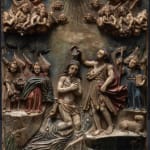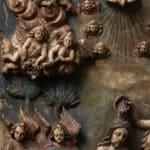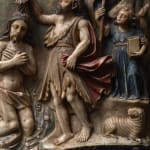THE BAPTISM OF CHRIST
Further images
Over the past four centuries, Huamanga stone carving has given rise to a unique diversity of artistic, cultural and ideological manifestations of the city of Ayacucho and its area of influence, putting itself at the service, over the years, of the requirements of the Catholic religion as imposed by the colonial powers. It would appear that, prior to the vice-regal period, there was no Huamanga stone-carving activity but, rather, that the Iberian artists and artisans in the province were the ones who began carving the alabaster between the end of the 16th and the beginning of the 17th centuries. The Huamanga alabaster took on the Quechua denomination of rumi child (stone child), in allusion to the religious sculptures of the Child Christ that proliferated in the vice-regal period, and due to its fragility. It is also known as berenguela, acting as a substitute for Western marble.
As we can observe in our relief, as well as in others from the same period, it is common to use gold leaf to coat certain figures, as well as the technique of wax encaustic. In the middle of the composition we find Christ, with his hands and arms folded over his chest in the midst of being baptized. He exerts a powerful presence over the surface and depth of the work, as does the figure of Saint John the Baptist who is baptizing him, through the use of a marine shell that not only stands for the element purifying the soul (water) but also its reward, in the form of the pearl, reminding us of the Parable of the Pearl in which a merchant, having come across a particularly beautiful one, went and sold everything he had in order to be able to buy it. Comparable, according to Christ, with the Kingdom of Heaven and our abandonment of everything else in order to attain God.
John the Baptist presents a great deal of movement thanks to his foreshortened posture and his clothing, which appears to be dancing in the wind. It is hard not to notice the high level of detail with which the work has been embellished. This denotes not only great skill on the part of the artist in technical terms, but also a real interest in making the viewer a participant and a discoverer of, for example, each one of the musical angels bearing different instruments, or perhaps the offerings and baskets with fruit and flowers that are encrusted with pearls, thereby lending the work a certain sparkle and shine. Reminding us, perhaps, of the inlay works originating from Peru and Mexico, whose use of mother-of-pearl was a legacy of Namban art. At John the Baptist’s feet there is a sheep representing God’s flock (Man) and below this, the rest of the species, in this case local to Peru, such as birds, reptiles, fish, molluscs and sea algae.







